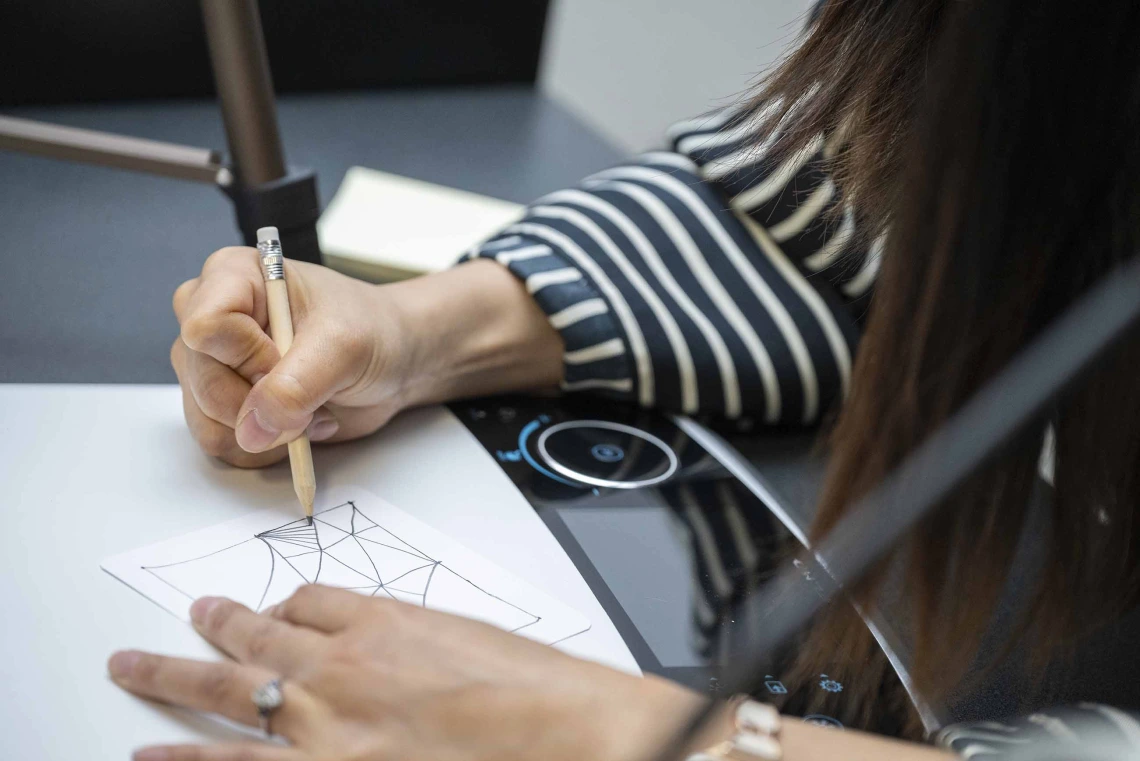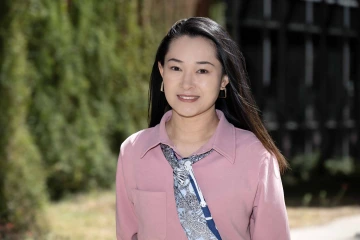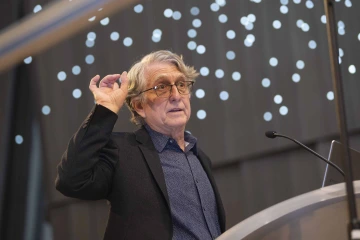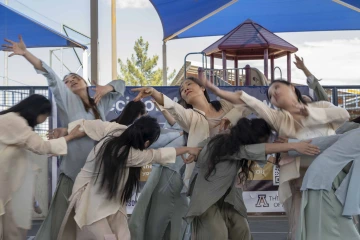Health Sciences colleges merge art and humanities with science
The wealth of arts and humanities programs offered boost wellness and help create more empathetic health care providers.

Whether it’s drawing, dancing or writing, engaging in the arts offers a creative outlet and can lead to better, more humanistic health care.
Photo by Noelle Haro-Gomez, U of A Health Sciences Office of Communications
Yunjia Yang, PhD, couldn’t bear to watch her beloved grandmother slip into the dark solitude of Alzheimer’s disease.
Her grandmother couldn’t recognize her anymore, so Yang — a trained dancer — tried to reach her in other ways. Yang played old music while she gently moved her body. Sadly, her paternal grandmother was too deep into the disease. Still, Yang decided it wasn’t too late to help others.

Yunjia Yang, PhD, teaches Creative Wellness: The Role of Arts in Public Health as well as leading spring workshops for U of A Mel and Enid Zuckerman College of Public Health staff, faculty and students. The class and workshops are new this semester, but Yang hopes they’ll continue and grow.
Photo by Noelle Haro-Gomez, U of A Health Sciences Office of Communications
The experience spurred Yang, a postdoctoral research associate at the University of Arizona Mel and Enid Zuckerman College of Public Health, to explore the cognitive and physical benefits of dance as a preventative therapy for dementia in her doctoral research. Now she’s taking things a step further through a new class and workshop series as part of the college’s Arts for Health and Wellness Initiative.
Yang teaches GHI 495/595 Creative Wellness: The Role of Arts in Public Health, which explores how the arts intersect with public health. The course offers hands-on experience and practical skills with a look at the arts in health care through a global context. She’s also leading spring workshops for U of A Zuckerman College of Public Health faculty, staff and students that she hopes will expand to all the U of A Health Sciences colleges. Known as Creative Arts for Lowering Mental Stress, or CALM, the different workshops use meditative doodling, music and dance to boost health and wellness.
“Arts in health is a fast-developing field in the U.S. and globally,” said Yang, who also teaches yoga and tai chi and is also a skilled Chinese calligrapher. “I’m excited to be a part of it.”
Building bonds
The connection between the arts and humanities and health education is undeniable.
“It’s bigger than just powers of observation; it’s getting in touch with your humanity by being able to look at things in different ways,” said Michael D. Dake, MD, senior vice president for the University of Arizona Health Sciences. “It’s a way to really force you out of habits and into new ways of thinking about things.”
As a radiologist, Dake said he’s always been drawn to visual arts.

Artist Jim Campbell created his digital art piece “Untangled Shadows” specifically for the soaring open space of the Health Sciences Innovation Building Forum as part of the visionary public art program envisioned by Michael D. Dake, MD, senior vice president of the U of A Health Sciences.
Photo by Noelle Haro-Gomez, U of A Health Sciences Office of Communications.
When he was a medical student, he spent some of his financial aid on a painting by Billy Al Bengston, a contemporary artist who pioneered the use of automobile lacquer and was known for his abstract work. Later, as a chief resident tasked with creating team-building exercises for his fellow residents, Dake organized lunchtime field trips and made sure to include local art museums.
So, it’s no surprise that Dake brought a visionary public art project to the Health Sciences Innovation Building. On a campus already brimming with great pieces and art centers, he zeroed in on something untapped — digital art. The El Mirador Project infuses art into health and science through the digital works of renowned artists.
“When you engage with this art, you can’t help but just wonder, ‘What are they doing? What is this?’ And everyone’s going to have their own interpretation,” Dake said.
The Association of American Medical Colleges published the Fundamental Role of Arts and Humanities in Medical Education to provide resources for medical educators to incorporate creative expression as an essential part of healing and humanistic care in 2020. Long before then, the U of A has been incorporating arts and humanities into its Health Sciences colleges through a variety of programs that tap into different creativities.
“You want your future physician to be well-rounded in the arts and humanities. It means they can be approachable, that they can connect to their patients,” said Tejal M. Parikh, MD, associate dean for admissions and director of the U of A College of Medicine – Tucson Comprehensive Education Center. “Once you’re able to establish a relationship with your patient, you’ve created a foundation of trust, this helps you collaborate, develop and follow through on clinical decisions even if that might involve uncomfortable procedures or taking medications.”
Seeing things differently
For 31 years, ArtWorks has spearheaded projects like collaborative murals and mosaics between adults with intellectual and developmental disabilities and U of A medical students who participate in the U of A College of Medicine – Tucson Commitment to Underserved People Program.
The award-winning U of A College of Medicine – Phoenix Art in Medicine program has used artwork to help its medical students improve not only their observational skills but also critical thinking and communication through assorted projects.
The power of words
The university’s two medical colleges also have programs that focus on narrative perspectives. The College of Medicine – Phoenix has the Program for Narrative Medicine and Health Care Humanities and, in 2018, launched a Certificate of Distinction in Health Humanities.
Building narrative competency not only honors patients’ stories and lived experiences but also results in more compassionate care as rapport for shared decision-making develops, said Jennifer R. Hartmark-Hill, MD, director of the Narrative Medicine program. It has added benefits for practitioners, too.
“Narrative practice also provides opportunities for health professionals to reflect meaningfully upon their own humanity, values and journeys as lifelong learners in the service of others,” Hartmark-Hill said.
Melody J. Glenn, MD, MFA, an assistant professor in emergency medicine and psychiatry, earned her master’s degree in creative writing and is a previous director of the U of A College of Medicine – Tucson Medical Humanities program. She said her writing background definitely enhanced her medical skills.

At the Feast for Your Brain event, Yunjia Yang, PhD, choreographed a dance that depicted her beloved grandmother’s battle with Alzheimer’s disease.
Photo by Noelle Haro-Gomez, U of A Health Sciences Office of Communications
“For me, the humanities and the arts have made me a much better physician and person,” said Glenn. “The skills involved in creative writing — listening, seeing your characters deeply and communicating the importance, the why of any given story —are the same skills utilized by talented physicians. It is the art of medicine.”
Glenn, who wrote a hybrid book-memoir about doctors battling opioid epidemics decades apart that publishes in July, said storytelling has helped her blend two very different kinds of medicine — emergency and addiction treatment — in a unique way.
“Art has the power to break down our mental silos and foster cross-disciplinary collaboration, which is exactly what we need to solve the big problems of our time,” she said.
Life enriching
For the past three years, the Zuckerman College of Public Health has been one of the sponsors of a community event that focuses on healthy aging. Called Feast for Your Brain, it’s a mix of performances, presentations, games, mind-body exercises and information. Last year, Yang choreographed a dance that shared her grandmother’s Alzheimer’s story.
Eventgoers were asked to jot down favorite memories on sticky notes, which were placed on dancers. As they moved around the stage, the papers fluttered off into the air, memories literally lost.
Yang said the arts are a handy tool in public health circles — a way to reach into the public and link patients with services, reduce stigma and isolation, or even just bring attention to a common health issue in an emotional way that can resonate more deeply.
“That’s the other part of the arts,” she said. “The arts can make the ordinary moment extraordinary, notable and memorable.”

